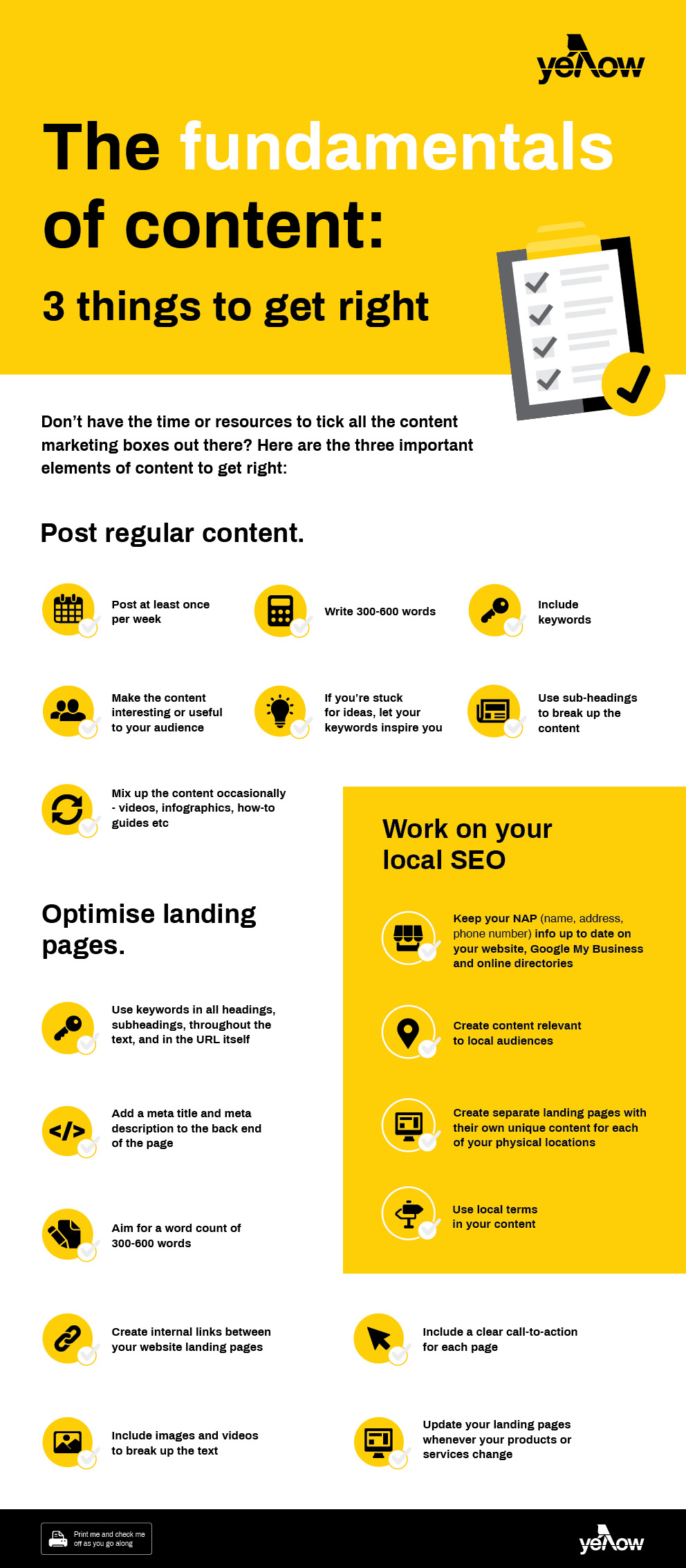Content marketing has long been a staple in any business’ toolkit.
It is the art of creating new content, such as articles, infographics, and videos for your website for marketing purposes. It has a multitude of benefits, but a key reason to invest in content marketing is its ability to improve brand awareness, with 80% of marketers saying that it achieves this goal, followed by 75% saying that content marketing builds credibility and trust and 70% saying that it educates audiences.
Creating your own content marketing strategy for small business is no small feat, but it is possible.
In this article explore key tips for business owners looking to reap the rewards of a strong content marketing plan. We will also provide some guidelines and ‘fundamentals’ for creating compelling content. And to ensure we lead by example, we have provided these guidelines in both written form as well as a handy infographic that you can download and refer to as you start to develop your own small business content marketing plan.
1. Create content with your sales funnel in mind.
A sales funnel is the journey that potential customers go through on the way to making a purchase from a business.
The standard sales funnel begins with awareness, where the audience becomes aware of your brand. This is followed by interest, where they take a closer look at what you offer, then intent, where they consider making a purchase. Finally, they take action.
Exactly what this customer journey looks like can vary from brand to brand, but any business can benefit from creating content that targets various stages of the funnel.
The objective of your content should differ depending on the stage of the funnel you’re targeting:
- Awareness: Provide relevant information your target audience is searching for, and offer a compelling introduction to your business.
- Interest: Meaningfully describe how your product or service solves a problem or offers value.
- Intent: Reaffirm your expertise and incentivise your audience to take the next step – making a purchase.
- Action: Answer specific questions your customers want to know about your product or service and the purchase process.
For example, a dental practice might create a content plan for each stage of the sales funnel that looks like this:
- Awareness: A video discussing the importance of dental health.
- Interest: An infographic explaining what happens during a initial check-up and clean
- Intent: An email newsletter offering a discount for new patients
- Action: An FAQ page with information about costs, billing, bookings etc.
2. Tailor your content types to your audience.
For your content marketing to reach the right people and be successful, it needs to be tailored to your specific audience.
When it comes to content preferences, 2021 research showed that although there are some similarities between age groups, there are some notable generational differences as well.
While all age groups named email as their top preferred marketing channel, younger consumers were more receptive to social media content and online advertising. Older generations still preferred more traditional marketing mediums such as TV ads, although digital marketing was gaining impact.
With your target audience in mind, it’s worthwhile testing a mix of content types and channels, and assessing what resonates most at the end of the month. This will inform what kinds of content to stick with when planning your marketing for the months ahead.
RELATED: Evergreen content and how it can help your brand.
3. Focus on evergreen content.
Evergreen content is any content that stays relevant for a long time – sometimes indefinitely.
Solid evergreen content is detailed, informative and optimised for search engines with relevant keywords and queries (words and phrases that people type into a search box to pull up a list of results).
Some evergreen content examples include:
- What is digital marketing?
- How to clean shower glass
- Fruit and vegetable seasons guide
- How to find a good electrician
- 30 easy exercises you can do at home
According to 2021 research by BuzzSumo and Backlinko, content types that are most likely to remain evergreen include lists, how-to guides, data-driven research and industry reports.
While it’s important to create seasonal content that’s relevant to your business at different times of the year, don’t overlook the value of evergreen content in attracting potential new customers. Done right, it can generate search traffic to your website all year round.
RELATED: Content Marketing Strategy Template.
Bonus: The fundamentals of content – 3 things to get right.
The world of content marketing is so vast that many businesses are surprised to hear that it takes an entire team of specialists to put together and execute a content marketing strategy.
So it’s no wonder that, as a small business owner, you might be feeling overwhelmed by the endless lists to keep an eye on, improve and work on.
If this sounds like you, but you only have so much time and a capped budget for your content marketing, it might pay to stick to the fundamentals and focus on getting them right, rather than spreading yourself too thin.
To make it easy for you, we’ve created a handy infographic guide to the fundamentals of content.
Here are the three content marketing fundamentals to focus on.
Create regular, quality written content.
‘Content is king’ has long been a staple of the content marketing industry, and while other areas have grown in importance, content is still one of the most important fundamentals of the field. After all, it’s right there in the name.
Set up a news/articles/blog section on your website, and regularly add quality content to keep this area fresh. The other advantage to posting regular content is that Google will crawl your site more regularly. Sites that update their content on a regular basis will enjoy greater visibility in the search engines as Google starts to see you as an authority in your particular vertical or field.
As a Google spokesman said when asked the question about regular content posting: “The more pages you have in the Google index, the more your content may show up in search results.” (Source)
Here’s what to aim for:
- Post at least once per week
- Write 300-600 words
- Make the content interesting or useful to your audience in some way
- Include keywords relevant to your work
- Use sub-headings to break up the content so it’s not a big block of text
- If you’re stuck for ideas, let your keywords inspire you
- Don’t forget that you can also add videos, infographics, how-to guides etc to your article – just like we have done here 🙂
And remember, the most valuable type of content you can publish is evergreen content.
Spend time on your local SEO.
Your local search engine optimisation (SEO) is extremely important, as almost half (46%) of all Google searches are made with local intent.
That means that when you’re thinking about your content marketing, at least some of your efforts should go towards your local market.
Here are the key ways you can use your content to improve your local SEO:
- Ensure your name, address, phone number (NAP info) is correct and clearly listed on your website
- Ensure your NAP info is listed and correct on Google Business Profile and online directories such as Yellow Pages Online
- Create content relevant to local audiences (for example, the best things to do in X area, best cafes in X, news relevant to your location)
- Create separate landing pages with their own unique content for each of your physical locations
- Use local terms in your content.
Optimise your landing pages.
Your landing pages are the main pages that make up your website, such as your homepage, service pages, pricing pages, about us page, etc.
It’s vital that these landing pages are optimised as part of your content marketing strategy. This will give them the best chance at ranking well in search engines, of helping your audiences find the information they need (rather than clicking away), and improving your sales.
Here are the basics you’ll need to get right:
- Use keywords in all headings, subheadings, throughout the text, and in the URL itself if relevant
- Add a meta title and meta description to the back end of the page (also including keywords)
- Aim for a word count of 300-600 words
- Create internal links between your website landing pages for easier navigation
- Include a clear call-to-action for each page (such as ‘contact us here’, or ‘buy now’, or ‘request a quote here’)
- Include images and videos to break up the text (you can also add keywords to the captions and alt text for better SEO)
- Update your landing pages whenever your products or services change.
Download your free infographic guide to the fundamentals of content below.
Creating regular content, looking after your local SEO and optimising your landing pages are the essentials of good content marketing, and will serve you well even if you don’t have the time or resources to do anything further.
Still have questions about digital marketing? Yellow Pages has the answers and the expertise. Get in touch to learn how we can help.

